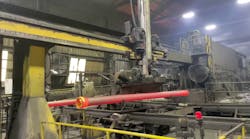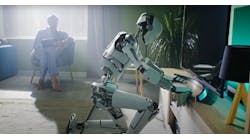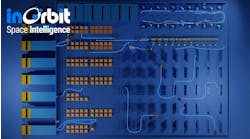The year is 1989. The first George Bush was sworn in as U.S. president; the Exxon Valdez oil spill occurred in Alaska; and the Berlin Wall was taken down. Far less significant than these events, it is the year I stared a career in industrial robotics.
Notable events in industrial robotics in 1989 included the start of a boutique company to look at advanced technologies to remove barriers between people and working robots; Motoman was formed; and another startup company was founded to develop robotic surgical tools.
How computing power changed robotics in the 1990s
In 1989, robots were not intelligent. They were primarily capable of performing rudimentary pick-and-place activities because of limitations in computing power. What changed this was the development of the desktop computer in the 1990s that allowed a robot to be controlled by a PC.
This also brought a steep reduction in microprocessor costs, meaning cheaper computing power and a higher level of programmability was available that stimulated rapid advancement in senor technology like the refinement of machine-vision systems and allowed for more intelligent tooling to be developed.
As these developments occurred, it became obvious that industrial robotics represented the future of manufacturing. This fueled the rapid increase in the use of this technology and the rapid expansion of market penetration during the next three decades.
My start was as an engineering manager at a small company that developed a cartesian case-packing system for bags of fragile confectionary products as an alternative to drop packers or side load machines that occasionally damaged the product.
Our system created a pack pattern for each layer in the box on an infeed conveyor and then picked one layer at time and placed it gently into a case for shipping. The technology at the time used stepper motors for the cartesian robot motion and infeed conveyor drive that provided positional feedback and motion control.
We used photo eyes to count the bags by breaking a beam as they passed and whisker type switches to locate the cases for packing—all controlled by a basic ladder logic scheme. This was leading-edge technology in robotic case packing at the time.
Decades of growth and transformation in industrial automation
Fast forward 35 years and, as many in our industry did, I held positions at four more robot manufacturers riding the wave of incredible growth and change during this time. So, what has changed, and what has stayed the same in industrial robotics since 1989?
We are still educating manufacturers in sales calls, at conferences and in webinars. The use of robotic technology is not yet universal outside of the automotive industry. Many manufacturers immediately think of adding more people to increase production instead of considering automation to do the job. Additionally, outside of current users and those in the industry, most people are unaware that this technology is working in the background making the products we use daily.
As an example, consider the products advertised during any event like the Super Bowl. Most of them are manufactured using factory automation systems and robots, yet we never see any ads for these systems or the robots. This illustrates how robotics technology is all around us and how critical it is to many manufacturing processes.
In the past, we were routinely asked “What do we do when the robot goes crazy?”
Due to the huge expansion in the use of microprocessors in our daily lives, people understand the power of these devices, and we are rarely asked this question anymore. This expansion and subsequent constant improvement in microprocessor capability has drastically increased our computing power and improved sensor and tooling technology. This has allowed us to achieve success in many more difficult applications than basic pick-and-place.
We now provide solutions for far more complex processes like grinding or material removal, painting, intricate assembly, specialized welding and tactile applications like surgery and handling sensitive items like biological products that vary in shape and size and are of a fragile nature.
Many manufactured products are now being designed to allow robots to assemble them, instead of being assembled by humans. This expedites the manufacturing process, reduces assembly time, increases quality and thus reduces product cost.
Examples are the use of plastic push button fasteners in lieu of mechanical fasteners like rivets or traditional screws or nuts and bolts. New facilities like e-commerce warehouses and many new manufacturing plants are being designed with layouts to accommodate automated material flow and automated processes, which also lowers overall costs.
Get your subscription to Control Design’s daily newsletter.
The rise of collaborative robots
Another recent development that was only a dream in 1989 is the collaborative robot (cobot). This robot can safely work with the human in shared tasks so the human can enter the robot’s workspace either on an occasional basis or for them to consistently work together.
Cobots are designed to be very simple to program, so less sophisticated personnel can program them and this allows for easy redeployment, which increases the flexibility in this investment. This feature vastly expanded the reach of all robotic automation systems into markets like food processing, farming, medical procedures, entertainment and personal care. The introduction of the cobot was as important to the expansion of the robotics industry as the microprocessor advances were in the 1990s.
What has not changed yet is that automotive applications still dominate the robot industry, accounting for around 50% of all robot sales yearly. But as we continue to educate other industries to see the benefits of this technology, those stats will change.
Rewarding careers in robotics
As a career, it was and remains a good choice for many reasons. We are exposed to variety in the applications and industries we work in, so it is not repetitious. Demand for employees has remained very high due to the tremendous yearly growth so competition is fierce for quality employees. It is a friendly industry with the automotive presence centered in southeast Michigan. Since many of us are neighbors, we work as friends even as we compete. A last tribute to the industry is the number of current retirees that started in the late 1980s and 1990s that remain a part of the industry as consultants and contract workers.
We are constantly blamed for taking jobs, but the applications we automate are dangerous, repetitious and high speed. We are removing people from unpleasant, unsafe jobs and giving them the opportunity to improve their situations and improve their positions. Maybe they will get hired in the robotics industry. I am aware of at least one open position.






